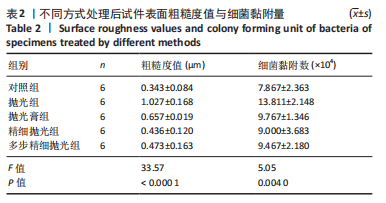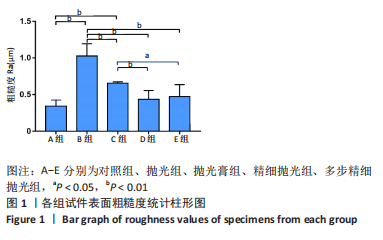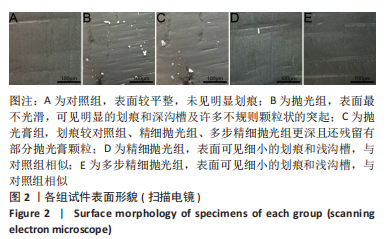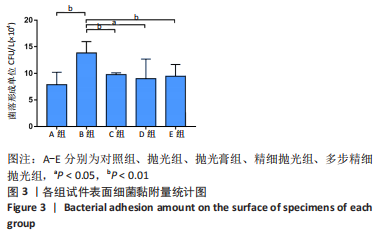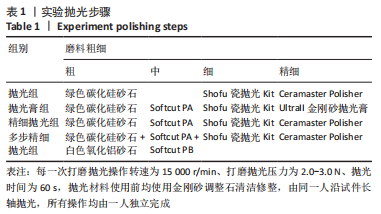中国组织工程研究 ›› 2023, Vol. 27 ›› Issue (21): 3320-3324.doi: 10.12307/2023.174
• 组织工程口腔材料 tissue-engineered oral materials • 上一篇 下一篇
不同抛光处理全氧化锆修复体的表面粗糙度和细菌黏附
曾尽娣1,宋晶晶1,张宇航1,杨征毅1,聂二民2,张春元2,姜 瑞2
- 1广州医科大学附属第一医院口腔科,广东省广州市 510405;2中山大学附属第一医院口腔科,广东省广州市 510080
Surface roughness and bacteria adhesion of full zirconia restoration after different polishing treatment
Zeng Jindi1, Song Jingjing1, Zhang Yuhang1, Yang Zhengyi1, Nie Ermin2, Zhang Chunyuan2, Jiang Rui2
- 1Department of Stomatology, The First Affiliated Hospital of Guangzhou Medical University, Guangzhou 510405, Guangdong Province, China; 2Department of Stomatology, The First Affiliated Hospital of Sun Yat-sen University, Guangzhou 510080, Guangdong Province, China
摘要:
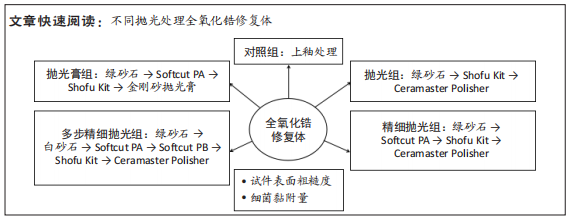
文题释义:
全氧化锆修复体:是指在计算机辅助设计与计算机辅助制造技术下,由单一的氧化锆块直接切削出具有全解剖形态的冠修复体,经过打磨、修整、抛光,然后通过配套的染色液染色技术上色、上釉,完成最终全氧化锆修复体的制作。制作过程中不需要先制作出基底内冠,也无需进行饰瓷等工艺,从根本上避免了饰瓷断裂的问题。表面抛光处理:抛光的主要原理是通过抛光工具去除试件表面的微小裂纹,并在一定程度上防止裂纹扩展,增加试件表面的光滑度,临床上表面抛光处理可分为磨光、平整、抛光、精细抛光4个阶段。
背景:临床上冠修复体表面抛光处理可有效减少色素沉着及菌斑黏附,且能够降低对颌牙的磨耗。
目的:研究不同抛光处理对全氧化锆修复体表面粗糙程度和细菌黏附的影响。
方法:制作30个的全氧化锆试件,尺寸为10 mm×10 mm×2 mm,随机分为5组(n=6):对照组(单纯上釉处理)、抛光组(绿色碳化硅砂石、Shofu瓷抛光Kit、Ceramaster Polisher抛光)、抛光膏组(绿色碳化硅砂石、Softcut PA、Shofu瓷抛光Kit、UltraII金刚砂抛光膏)、精细抛光组(绿色碳化硅砂石、Softcut PA、Shofu瓷抛光Kit、Ceramaster Polisher抛光)、多步精细抛光组(绿色碳化硅砂石+白色氧化铝砂石、Softcut PA+Softcut PB、Shofu瓷抛光Kit、Ceramaster Polisher抛光)。测试各组试件处理后的表面粗糙度值和表面形态及表面变形链球菌黏附情况。
结果与结论:①5组试件的表面粗糙度值由高到低为:抛光组、抛光膏组、多步精细抛光组、精细抛光组、对照组,抛光组粗糙度值高于其他4组(P < 0.05),抛光膏组粗糙度值高于对照组、精细抛光组、多步精细抛光组(P < 0.05);②扫描电镜下可见,对照组试件表面较平整未见明显划痕;精细抛光组、多步精细抛光组与对照组相似;抛光膏组试件表面的划痕深且伴有小颗粒;抛光组表试件面最不光滑,可见明显的划痕和深沟槽以及许多不规则颗粒状的突起;③5组试件表面细菌黏附量由高至低依次为:抛光组、抛光膏组、多步精细抛光组、精细抛光组、对照组,抛光组细菌黏附量显著高于其他4组(P < 0.01);④结果表明,Shofu的精细抛光和多步精细抛光方案均能有效提高全氧化锆试件表面的光洁度,减少表面细菌黏附,效果堪比上釉。
https://orcid.org/0000-0002-5628-2858(曾尽娣)
中国组织工程研究杂志出版内容重点:生物材料;骨生物材料;口腔生物材料;纳米材料;缓释材料;材料相容性;组织工程
中图分类号:
